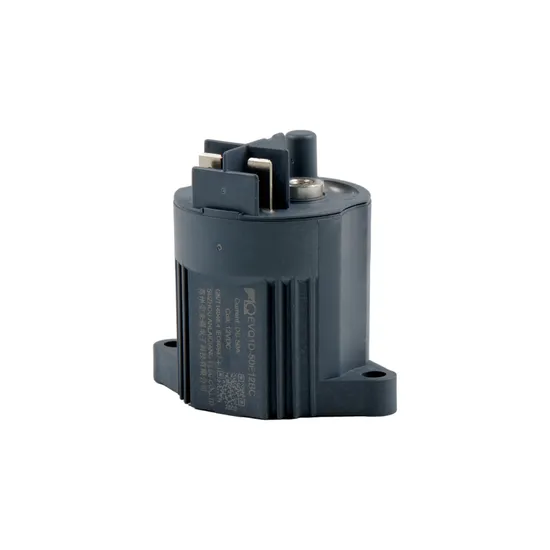
High Voltage DC Contactor for Power Battery System 50A 1000V
| US$8.69-14.49 | 100 Pieces (MOQ) |
Basic Info.
Model NO.
EVQ1D-50E12BC
Phase
1
Main Circuit Rating Voltage
1000V
Main Circuit Rating Current
50A
Type
Dc Contactors
Power Contact Polar
Non-Polarized
Rated Operatinge Voltage
1000V DC
Max.Continuous Current(at 23ºC)
50A
Coil Voltage
12VDC
Transport Package
Carton
Specification
110g
Trademark
ALQ
Origin
Suzhou
HS Code
8536410000
Production Capacity
50000pieces/Year
Packaging & Delivery
Package Size
40.00cm * 38.50cm * 11.50cm
Package Gross Weight
8.800kg
Product Description
Product DescriptionFeatures
Epoxy packaging, the contacts are protected by nitrogen, preventing oxidation, strong cooling arc capacity.
High-voltage, high-current control capable.
Compact & low operating sound.
Safety and high contact reliability.
Can be installed in any direction.
Not freezing and condensing at low temperature.
Applications
Pre-charge
Energy storage equipment
Power battery system
High voltage inverter
Power contact
| Parameter | Data |
| Contact arrangement | 1 Form X(SPST-NO-DM) |
| Contact polar | Without polarity |
| Power contact material | Copper or silver alloy optional, see "Part numbering system" |
| Rated operating voltage | 1,000V DC |
| Max. Continuous current(at 23ºC) | 50A |
Exhibition
FAQ
Q1: Are you trading company or manufacturer ?
We are a manufacturer.
Q2:What can you do if the product is broken?
Our products come with a one-year warranty from the date of acceptance. If any part breaks within this period and cannot be repaired, we will replace it with a new one. Please note that you will need to cover the shipping costs. After the warranty period, we can negotiate solutions and provide lifetime technical support for our equipment.
Q3:Why should we choose your company?
1. Our company is certified with CE, TUV, UL, RoHS, and IATF16949:2016, among others.
2. We offer advanced technical support and maintain a strict quality management system.
3. We provide efficient and timely service through email, WhatsApp, Facebook, and other channels.
Q4:What is the difference between an epoxy contactor and a ceramic contactor?
1. The sealed materials and processes differ: epoxy contactors use epoxy resin and require a baking process, while ceramic contactors use technical ceramics and require laser brazing. 2. The internal filling gases are different: epoxy contactors are filled with nitrogen, whereas ceramic contactors are filled with hydrogen. 3. The return signal function in ceramic contactors is less stable and reliable compared to epoxy contactors.
>> Plastic Granulate Machine Plastic Recycling Plastic Pellet Machine
>> High Quality FIBC Bulk Bag with Color PP Fabric
>> New Hair Plastic Coloring Trolley Trolley with Magnetic Bowl
>> High-Precision Horizontal Gantry Diamond Wire Saw Cutting Machine for Quartz Glass Jade Stone Ceramic Silicon
>> stable performance cute design convertible free shuttle
>> B Series Professional Luxury Aluminum Rowing Boat Motor Boat Welded Craft Affordable Marine Boat
>> High-Speed CNC Drilling Machine for Heavy Steel Beams
>> Ckmine 1000W Modified Sine Wave Inverter DC 12V to AC 220V off Grid Power Converter ODM OEM
>> Square Column Universal Drilling Machine Z5180 Manual Drilling Machine Vertical Drilling Machine
>> CO2 Foaming PS Skirting Moulding Extrusion Line/Production Line
>> Pull Hitch Three Point Combined Tillage Machine Power Disc Harrow Tiller Round Disc Power
>> Hicas Infrared Baking Lamp PVC Wood Edge Banding Machine
>> Brand new original millet water spray sweeper 350ml Deerma spray mop
>> Fashion Polyester Colorful Pattern Tie, Men′s Custom Pattern Tie, Yarn-Dyed Jacquard Necktie
>> Factory TPU Hose for Wastewater Bypass and Irrigation Water Transfer
>> SHENGKE Hot Sale Gold Wristwatch 3ATM Water Resist Quartz Handwatchs Magnetic Buckle Dropshipping Wacths K0059L
>> Latest Products High Quality Horizontal Vertical Metal Turret Baga Nmk-70s
>> Tavol Fork Lift Truck 1.5t/2t/2.5t/3t/3.5t Electric/Diesel Forklift Price with Attachment
>> Direct Sale! ! ! Warehouse Good Quality Wheel Diesel Electric Hydraulic Telescopic Gasoline Mini Forklift Truck and Part Swith Low Price for Sale
>> 2020 New Arrival FDY Nylon Yarn Dope Dyed Black 1680d 9g/D High Tenacity Yarn for Safe Belt
>> Factory Cheap Wheeled Mobile Excavator / Multifunctional Wheel Excavator / Medium Wheel Excavators with Attachments for Sale
>> Plastic PP PE Pipe/Film/Tank Waste Recycling Pelletizing Granulation Equipment
>> Wholesale Bike Repair Tool Kits 16 in 1 Pocket Mini Portable
>> Automatic Different Capacity Stainless Steel Premix Animal Feed Mill Mixer
>> China supplier cnc precision machining cast iron bearing housing
>> Hot Sale Aluminium Designer window glass doors for commercial Thermal Break Aluminum Casement window
>> Acacia Wood Household Simple Desktop Tea Bag Coffee Bag Three Compartment Storage Box
>> UKISS Luxury Body Parts For BMW 3 Series F 30 F 35 change to MP Style Carbon Fiber Interior Trim Automotive Interior
>> China Supplier Jiangsign Waterproof PVC Film Train Wagon Tarp Cover Tarpaulin
>> HC-S105 Advanced full-featured nursing person training model (female)/Medical nursing manikin for medical training